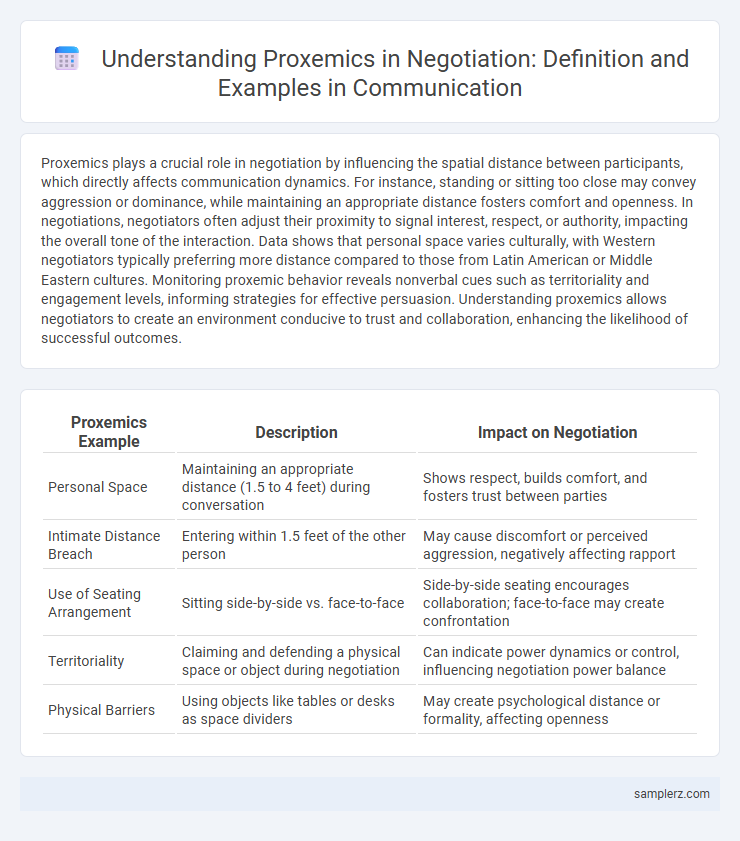Proxemics plays a crucial role in negotiation by influencing the spatial distance between participants, which directly affects communication dynamics. For instance, standing or sitting too close may convey aggression or dominance, while maintaining an appropriate distance fosters comfort and openness. In negotiations, negotiators often adjust their proximity to signal interest, respect, or authority, impacting the overall tone of the interaction. Data shows that personal space varies culturally, with Western negotiators typically preferring more distance compared to those from Latin American or Middle Eastern cultures. Monitoring proxemic behavior reveals nonverbal cues such as territoriality and engagement levels, informing strategies for effective persuasion. Understanding proxemics allows negotiators to create an environment conducive to trust and collaboration, enhancing the likelihood of successful outcomes.
Table of Comparison
| Proxemics Example | Description | Impact on Negotiation |
|---|---|---|
| Personal Space | Maintaining an appropriate distance (1.5 to 4 feet) during conversation | Shows respect, builds comfort, and fosters trust between parties |
| Intimate Distance Breach | Entering within 1.5 feet of the other person | May cause discomfort or perceived aggression, negatively affecting rapport |
| Use of Seating Arrangement | Sitting side-by-side vs. face-to-face | Side-by-side seating encourages collaboration; face-to-face may create confrontation |
| Territoriality | Claiming and defending a physical space or object during negotiation | Can indicate power dynamics or control, influencing negotiation power balance |
| Physical Barriers | Using objects like tables or desks as space dividers | May create psychological distance or formality, affecting openness |
Understanding Proxemics in Negotiation
In negotiation, proxemics plays a critical role by influencing personal space and physical distance between parties, which affects trust and openness. Maintaining an appropriate distance, typically around 1.5 to 4 feet in business settings, helps create a comfortable environment that encourages dialogue and mutual respect. Misreading proxemics cues, such as invading personal space, can lead to discomfort or perceived aggression, potentially derailing successful negotiation outcomes.
The Role of Personal Space at the Negotiation Table
Personal space significantly influences the dynamics at the negotiation table, with proxemics affecting comfort levels and communication effectiveness between parties. Maintaining an appropriate distance respects cultural and individual boundaries, fostering trust and openness during discussions. Violating personal space can lead to discomfort, reduced cooperation, and potential conflict, underscoring the importance of spatial awareness in negotiation strategies.
Proxemic Zones: How Distance Affects Negotiation Outcomes
Proxemic zones categorized as intimate (0-18 inches), personal (18 inches-4 feet), social (4-12 feet), and public (12 feet or more) significantly influence negotiation outcomes by impacting comfort and trust levels. For instance, maintaining a social distance of 4-12 feet in cross-cultural negotiations helps establish professionalism while reducing perceived threat. Research shows that negotiators who effectively manage proxemic distances experience higher cooperation rates and more favorable agreements.
Cultural Variations in Proxemics During Negotiations
Cultural variations in proxemics significantly impact negotiation dynamics, as distance preferences differ widely across cultures; for example, Latin American negotiators often prefer closer physical proximity to build trust, while Northern Europeans may maintain more personal space to demonstrate professionalism. Understanding these cultural proxemic norms helps negotiators avoid misinterpretations of intentions and maintain effective communication. Adapting negotiation strategies to respect cultural proxemics can improve rapport and facilitate successful outcomes.
Power Dynamics Expressed Through Spatial Positioning
In negotiation settings, proxemics reveals power dynamics through spatial positioning, where dominant negotiators occupy central or elevated spaces to assert control and influence. The distance maintained between parties often reflects authority levels, with those in power positioning themselves closer to key decision-makers while subordinates remain peripheral. This spatial arrangement non-verbally communicates hierarchy and impacts the flow and outcome of negotiations.
Strategic Use of Space to Influence Negotiation Results
Strategic use of proxemics in negotiation involves deliberately managing physical distance to convey power, trust, or openness, influencing the counterpart's perception and behavior. For instance, maintaining closer proximity can signal confidence and assertiveness, while respectful distance may foster cooperation and reduce tension. Skilled negotiators adjust spatial dynamics to create psychological advantage, subtly shaping the negotiation outcome.
Examples of Effective Proxemics in Business Negotiations
Effective proxemics in business negotiations includes maintaining an appropriate physical distance to foster trust and comfort, such as sitting at a moderate distance to signal openness without invading personal space. Using spatial arrangements, like positioning chairs at a 90-degree angle, can promote collaboration and reduce perceived aggression. Observing cultural variations in proxemics ensures respectful interactions, improving communication effectiveness and negotiation outcomes.
Misinterpretations of Proxemics and Negotiation Breakdown
Misinterpretations of proxemics during negotiation often lead to breaches of personal space that cause discomfort and mistrust, undermining productive dialogue. For example, standing too close may be perceived as aggression, while excessive distance can signal disinterest or evasiveness, resulting in emotional disengagement. These spatial misunderstandings frequently contribute to negotiation breakdowns by obstructing effective communication and collaboration between parties.
Adapting Proxemics for Virtual Negotiations
Adapting proxemics in virtual negotiations involves managing digital spatial cues such as screen placement, camera angles, and personal background to influence perceived closeness and credibility. Virtual negotiators adjust their on-screen positioning and virtual backgrounds to create a sense of professionalism and psychological comfort, compensating for the absence of physical proximity. Effective use of these digital proxemic strategies enhances trust and facilitates smoother communication in online negotiation settings.
Tips for Utilizing Proxemics to Enhance Negotiation Success
Maintaining appropriate personal distance during negotiation signals respect and fosters trust, crucial for positive outcomes. Use spatial awareness by adjusting seating arrangements to match the formality and emotional tone, enhancing comfort and openness. Observing and mirroring the other party's proxemic cues can build rapport and facilitate more effective communication.

example of proxemics in negotiation Infographic
 samplerz.com
samplerz.com